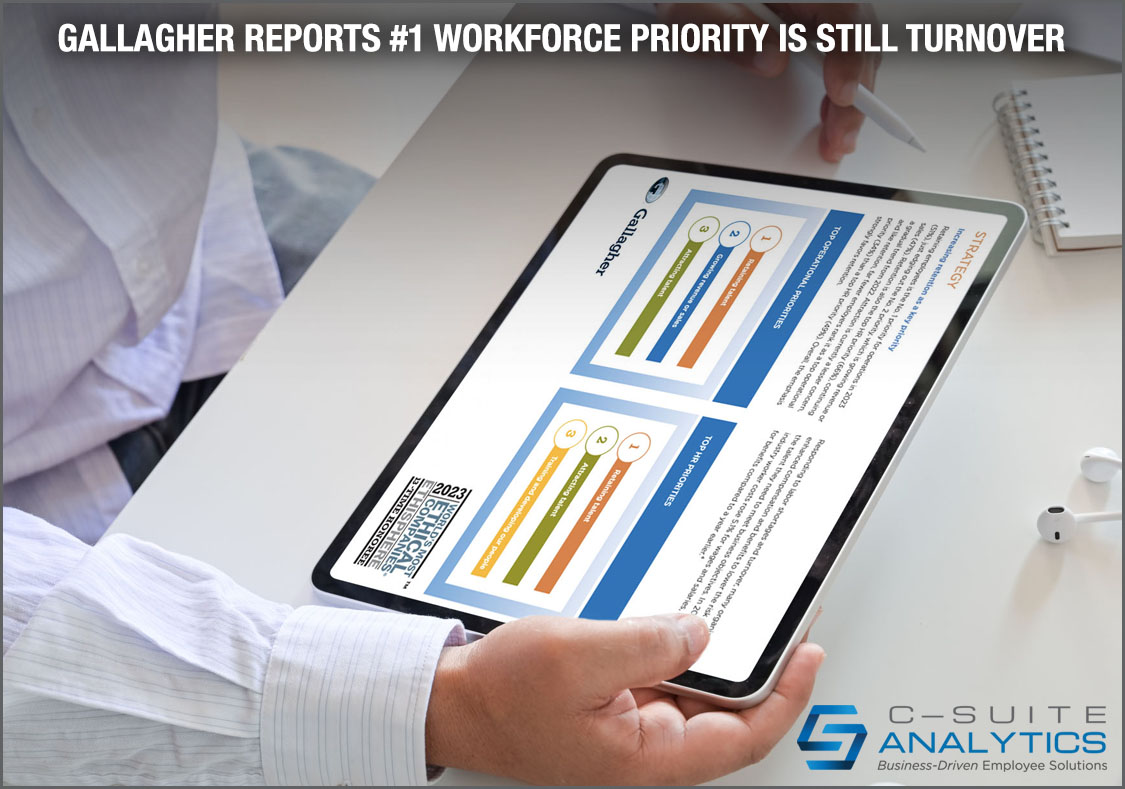Most hiring tools answer whether candidates can and will do the job, but not if they’ll stay. Learn how realistic job previews and motivational-fit interviews can improve retention from day one.
Gallagher Reports #1 Workforce Priority is Still Turnover

A funny writer recently said that the only thing more on-and-off than recession predictions is Ross and Rachel. And we have similarly wish-washy projections for “The Great Resignation”, as in is it sticking around or has it run its course?
The Reports, Numbers, and Trends Don’t Lie About Employee Retention
What is consistent, though, are reports that employee quitting remains strong. So strong in fact that the highly-respected Gallagher 2023 Workforce Trends Report says in their survey of 4,000+ organizations that employee retention remains priority #1.[i] A full 66% of HR executives say so, but more eye-grabbing is that greater than half of operations executives said the same. This means the manufacturing execs who must get product out the door now see turnover as their main obstacle, just as healthcare CEOs are seeing nurse turnover as the major driver of patient-care shortcomings along with ever-increasing agency costs.
The deep-seated cause is not “The Great Resignation” but is instead “workforce shortages”. Get ready to see less of the former term and more of the latter. I could list bunches of contributing data here including as just one example that COVID has removed more than a quarter million people from our workforce. But the major factor is baby boomers are retiring and there are flat-out not enough native-born Americans to replace them. During the next ten years our total U.S. workforce will grow at a slower pace than at any time in our history, all while striving to retain our position as the world’s top economy. Side-stories abound but here are two:
- Our Census Bureau says 51% of new workers will be immigrants beginning in 2030, and that percentage will increase for as far out as they can predict.[ii]
- Whereas baby-boomers have stayed with employers an average of 8 years 3 months, millennials stay 2 years 9 months and gen Z an average of 2 years 3 months.[iii]
Making this last point scarier, millennials and gen Z comprise a full 51% of today’s U.S. workforce…and millennials alone will dominate by being 75% of the workforce by 2025. Remember when we said young workers can’t keep up the constant job-hopping because the economic realities of adulthood, families, and rest will eventually sink in? Young workers have won, assisted by the historically high number of job openings that isn’t going away.
Right Problem, Wrong Solution for Cutting Turnover
But here’s where the Gallagher report gets way off course because their opening solution for cutting turnover is about pay:
Retention far out-ranks other top operational and HR priorities in 2023 – putting total rewards and the employee experience in the spotlight, right alongside heavy investment in base salaries.
And they go on to say…
Responding to labor shortages and turnover, many organizations enhanced compensation and benefits to lower the risk of losing the talent they need to meet business objectives. In 2022, private industry worker costs rose 5.1% for wages and salaries, and 4.8% for benefits compared to a year earlier.
We could offer Gallagher a pass regarding their comp and benefit bias because they are a for-profit consulting firm that added a sub-title to their report which reads, “Benchmarks for benefits, HR, and people strategies to help organizations thrive”.
Yet I would ask Gallagher this question:
Can you show me proof, actual academic research, that says that increasing pay or benefits provides a long-term impact on employee retention?
I don’t think they can. Nor can Gallup or any other research and consulting organization. And no one is predicting “The Great Resignation” is over because employers have raised pay.
HR’s Greatest Challenge is the name of a book I authored several years ago that contains summaries of 25 highly-respected studies that all point in the same direction…that the #1 reason employees stay or leave, or engage or disengage, is how much they trust their boss.
Yet organizations continue to listen to consultants who put them on this path:
- Review engagement survey and exit survey results.
- Identify the top employee concerns.
- Appoint an employee committee to identify solutions.
- Implement one-size-fits-all solutions.
- Re-survey to find the same problem has not improved.
Example: Employees’ top concern is recognition so solutions include employee-of-the-month, employee appreciation week, free parking space, get a backpack at 5 years and a clock at ten. Then future reports show no improvement.
Focus on Individuals, Not Systems and Surveys for Employee Retention
Failure here is because employees are asking that their manager recognize them instead of a system. That as humans we crave for human emotional experiences that are sourced from someone important to us…in this case the one person we interact with each day who determines our job security along with our daily feelings about our jobs.
You can read more about the sketchy impact pay has on retention, along with 6 examples of clients across all industries that have cut turnover by 20% and more by implementing Stay Interviews and holding leaders accountable for retention goals.
We should thank Gallagher for their excellent research about the importance of employee retention. And then we all need to become better informed on why employees quit and how to fix it.
Need help establishing retention goals based on trust not pay?
Schedule a conversation with me at DFinnegan@C-SuiteAnalytics.com and we’ll discuss the numbers and needs you should have to evaluate your retention goals. We work with companies in every type of industry to cut turnover by 20% and more by building trust and accountabilities.
[i] https://www.ajg.com/us/-/media/files/gallagher/us/2023/workforce-trends-report-2023-organizational-wellbeing.pdf
[ii] https://www.census.gov/library/publications/2020/demo/p25-1144.html
[iii] https://www.careerbuilder.com/advice/blog/how-long-should-you-stay-in-a-job



